Feasibility Analysis of Computer Assisted Education System
VerifiedAdded on 2023/04/21
|13
|3139
|287
Report
AI Summary
This report investigates the feasibility of computer-assisted education by comparing it to traditional learning methods. It addresses research questions about the differences between modern and traditional approaches, problems faced by traditional education systems, and the feasibility of computer-aided education in the modern context. The research employs a descriptive research design with a quantitative technique, utilizing primary data collected through online surveys. The report includes a literature review on the use of computers and the internet in education, a detailed methodology section outlining the research design, data collection, and analysis methods, a Gantt chart for project timeline, risk identification, ethical considerations, and technological requirements. The findings are analyzed using SPSS to determine the feasibility of integrating computer-assisted education to enhance learning outcomes.
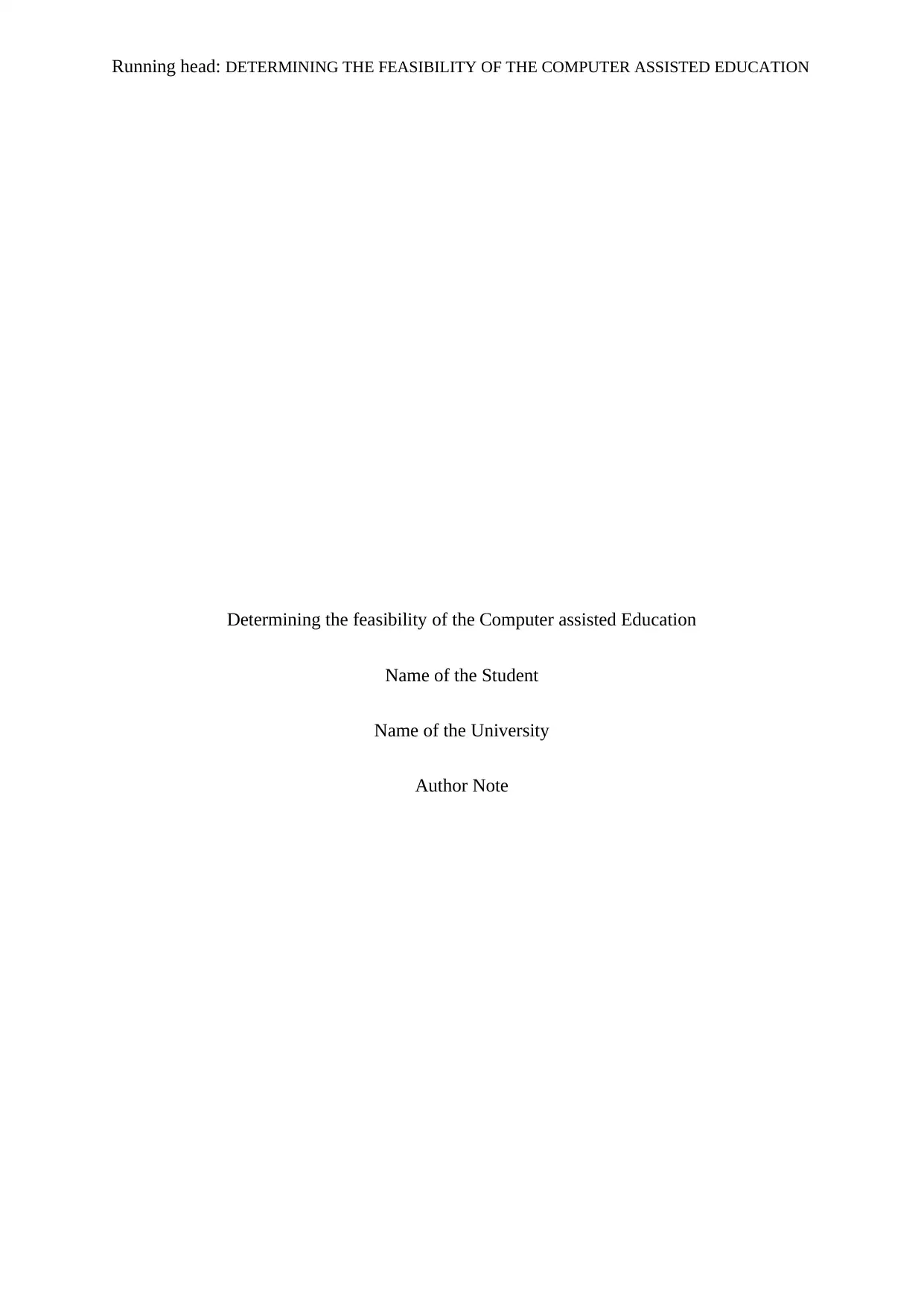
Running head: DETERMINING THE FEASIBILITY OF THE COMPUTER ASSISTED EDUCATION
Determining the feasibility of the Computer assisted Education
Name of the Student
Name of the University
Author Note
Determining the feasibility of the Computer assisted Education
Name of the Student
Name of the University
Author Note
Paraphrase This Document
Need a fresh take? Get an instant paraphrase of this document with our AI Paraphraser
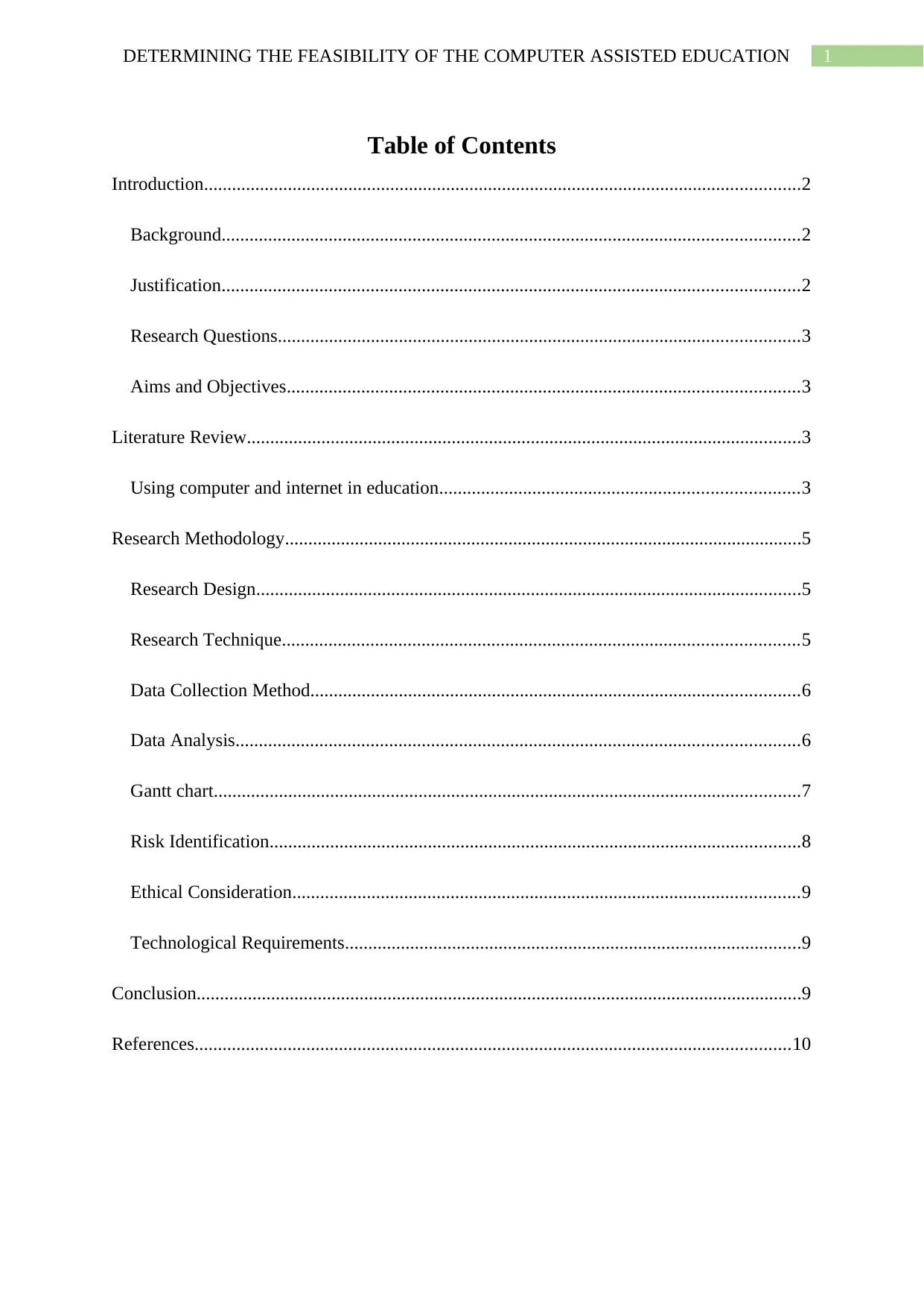
1DETERMINING THE FEASIBILITY OF THE COMPUTER ASSISTED EDUCATION
Table of Contents
Introduction................................................................................................................................2
Background............................................................................................................................2
Justification............................................................................................................................2
Research Questions................................................................................................................3
Aims and Objectives..............................................................................................................3
Literature Review.......................................................................................................................3
Using computer and internet in education.............................................................................3
Research Methodology...............................................................................................................5
Research Design.....................................................................................................................5
Research Technique...............................................................................................................5
Data Collection Method.........................................................................................................6
Data Analysis.........................................................................................................................6
Gantt chart..............................................................................................................................7
Risk Identification..................................................................................................................8
Ethical Consideration.............................................................................................................9
Technological Requirements..................................................................................................9
Conclusion..................................................................................................................................9
References................................................................................................................................10
Table of Contents
Introduction................................................................................................................................2
Background............................................................................................................................2
Justification............................................................................................................................2
Research Questions................................................................................................................3
Aims and Objectives..............................................................................................................3
Literature Review.......................................................................................................................3
Using computer and internet in education.............................................................................3
Research Methodology...............................................................................................................5
Research Design.....................................................................................................................5
Research Technique...............................................................................................................5
Data Collection Method.........................................................................................................6
Data Analysis.........................................................................................................................6
Gantt chart..............................................................................................................................7
Risk Identification..................................................................................................................8
Ethical Consideration.............................................................................................................9
Technological Requirements..................................................................................................9
Conclusion..................................................................................................................................9
References................................................................................................................................10
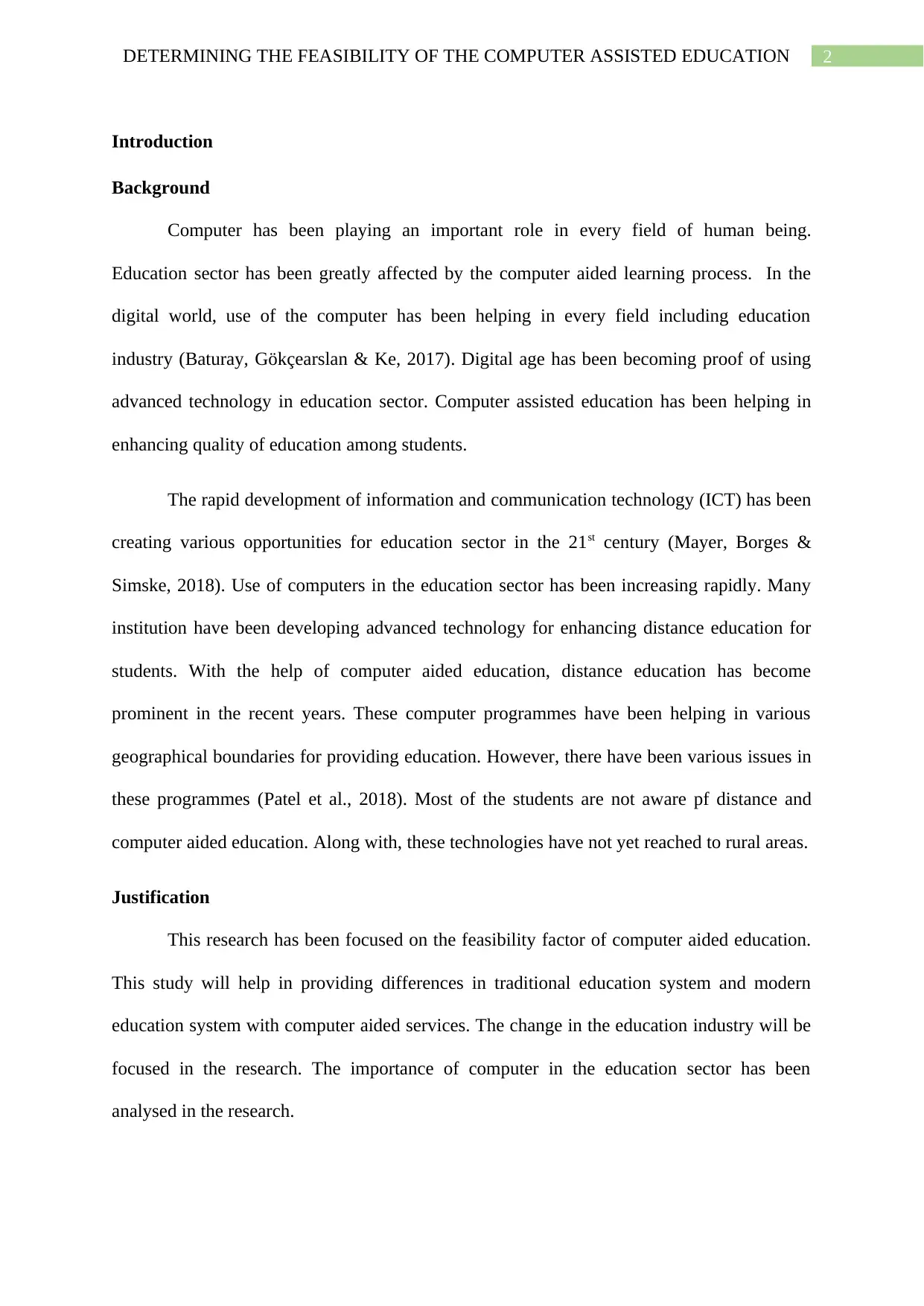
2DETERMINING THE FEASIBILITY OF THE COMPUTER ASSISTED EDUCATION
Introduction
Background
Computer has been playing an important role in every field of human being.
Education sector has been greatly affected by the computer aided learning process. In the
digital world, use of the computer has been helping in every field including education
industry (Baturay, Gökçearslan & Ke, 2017). Digital age has been becoming proof of using
advanced technology in education sector. Computer assisted education has been helping in
enhancing quality of education among students.
The rapid development of information and communication technology (ICT) has been
creating various opportunities for education sector in the 21st century (Mayer, Borges &
Simske, 2018). Use of computers in the education sector has been increasing rapidly. Many
institution have been developing advanced technology for enhancing distance education for
students. With the help of computer aided education, distance education has become
prominent in the recent years. These computer programmes have been helping in various
geographical boundaries for providing education. However, there have been various issues in
these programmes (Patel et al., 2018). Most of the students are not aware pf distance and
computer aided education. Along with, these technologies have not yet reached to rural areas.
Justification
This research has been focused on the feasibility factor of computer aided education.
This study will help in providing differences in traditional education system and modern
education system with computer aided services. The change in the education industry will be
focused in the research. The importance of computer in the education sector has been
analysed in the research.
Introduction
Background
Computer has been playing an important role in every field of human being.
Education sector has been greatly affected by the computer aided learning process. In the
digital world, use of the computer has been helping in every field including education
industry (Baturay, Gökçearslan & Ke, 2017). Digital age has been becoming proof of using
advanced technology in education sector. Computer assisted education has been helping in
enhancing quality of education among students.
The rapid development of information and communication technology (ICT) has been
creating various opportunities for education sector in the 21st century (Mayer, Borges &
Simske, 2018). Use of computers in the education sector has been increasing rapidly. Many
institution have been developing advanced technology for enhancing distance education for
students. With the help of computer aided education, distance education has become
prominent in the recent years. These computer programmes have been helping in various
geographical boundaries for providing education. However, there have been various issues in
these programmes (Patel et al., 2018). Most of the students are not aware pf distance and
computer aided education. Along with, these technologies have not yet reached to rural areas.
Justification
This research has been focused on the feasibility factor of computer aided education.
This study will help in providing differences in traditional education system and modern
education system with computer aided services. The change in the education industry will be
focused in the research. The importance of computer in the education sector has been
analysed in the research.
You're viewing a preview
Unlock full access by subscribing today!
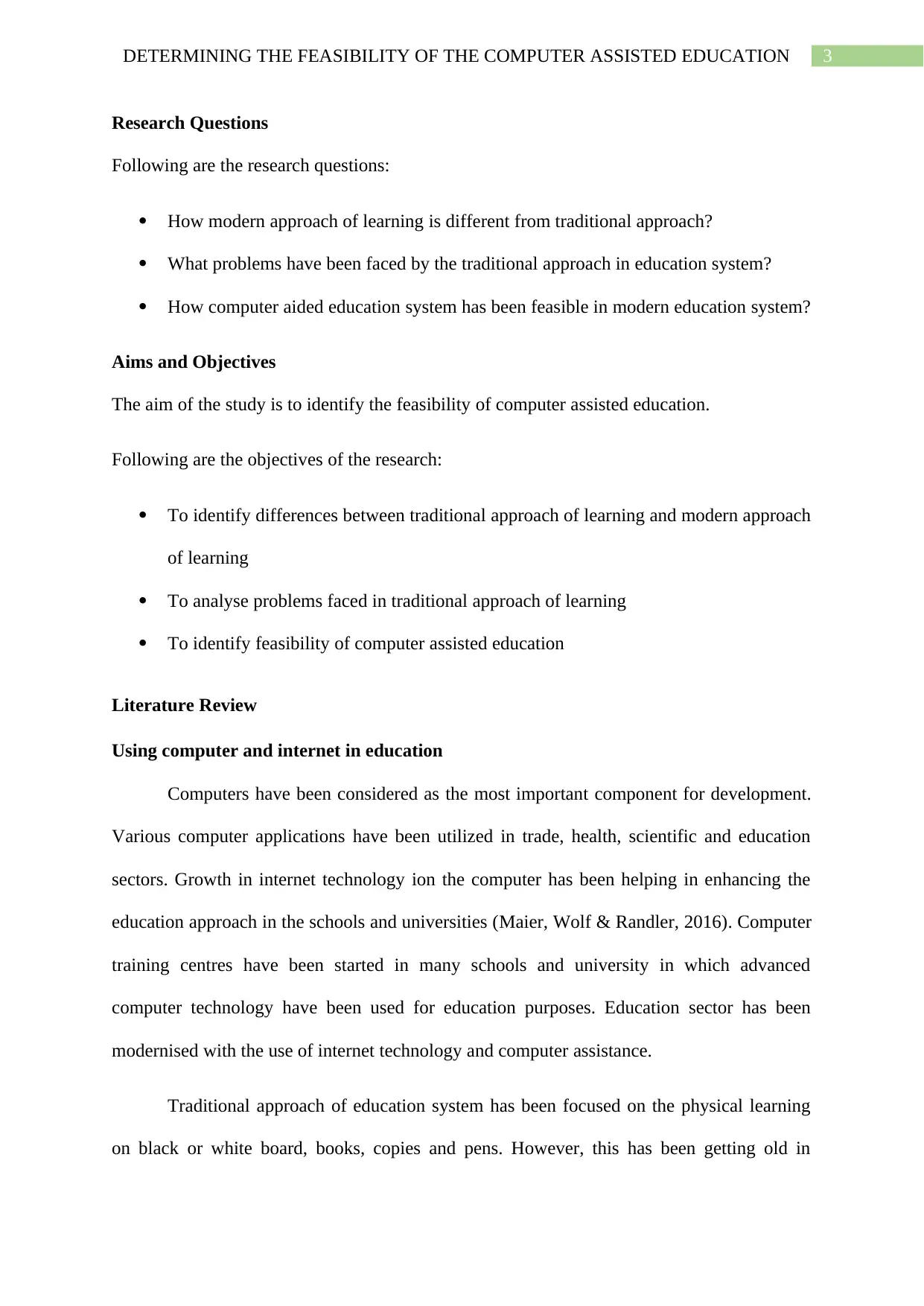
3DETERMINING THE FEASIBILITY OF THE COMPUTER ASSISTED EDUCATION
Research Questions
Following are the research questions:
How modern approach of learning is different from traditional approach?
What problems have been faced by the traditional approach in education system?
How computer aided education system has been feasible in modern education system?
Aims and Objectives
The aim of the study is to identify the feasibility of computer assisted education.
Following are the objectives of the research:
To identify differences between traditional approach of learning and modern approach
of learning
To analyse problems faced in traditional approach of learning
To identify feasibility of computer assisted education
Literature Review
Using computer and internet in education
Computers have been considered as the most important component for development.
Various computer applications have been utilized in trade, health, scientific and education
sectors. Growth in internet technology ion the computer has been helping in enhancing the
education approach in the schools and universities (Maier, Wolf & Randler, 2016). Computer
training centres have been started in many schools and university in which advanced
computer technology have been used for education purposes. Education sector has been
modernised with the use of internet technology and computer assistance.
Traditional approach of education system has been focused on the physical learning
on black or white board, books, copies and pens. However, this has been getting old in
Research Questions
Following are the research questions:
How modern approach of learning is different from traditional approach?
What problems have been faced by the traditional approach in education system?
How computer aided education system has been feasible in modern education system?
Aims and Objectives
The aim of the study is to identify the feasibility of computer assisted education.
Following are the objectives of the research:
To identify differences between traditional approach of learning and modern approach
of learning
To analyse problems faced in traditional approach of learning
To identify feasibility of computer assisted education
Literature Review
Using computer and internet in education
Computers have been considered as the most important component for development.
Various computer applications have been utilized in trade, health, scientific and education
sectors. Growth in internet technology ion the computer has been helping in enhancing the
education approach in the schools and universities (Maier, Wolf & Randler, 2016). Computer
training centres have been started in many schools and university in which advanced
computer technology have been used for education purposes. Education sector has been
modernised with the use of internet technology and computer assistance.
Traditional approach of education system has been focused on the physical learning
on black or white board, books, copies and pens. However, this has been getting old in
Paraphrase This Document
Need a fresh take? Get an instant paraphrase of this document with our AI Paraphraser
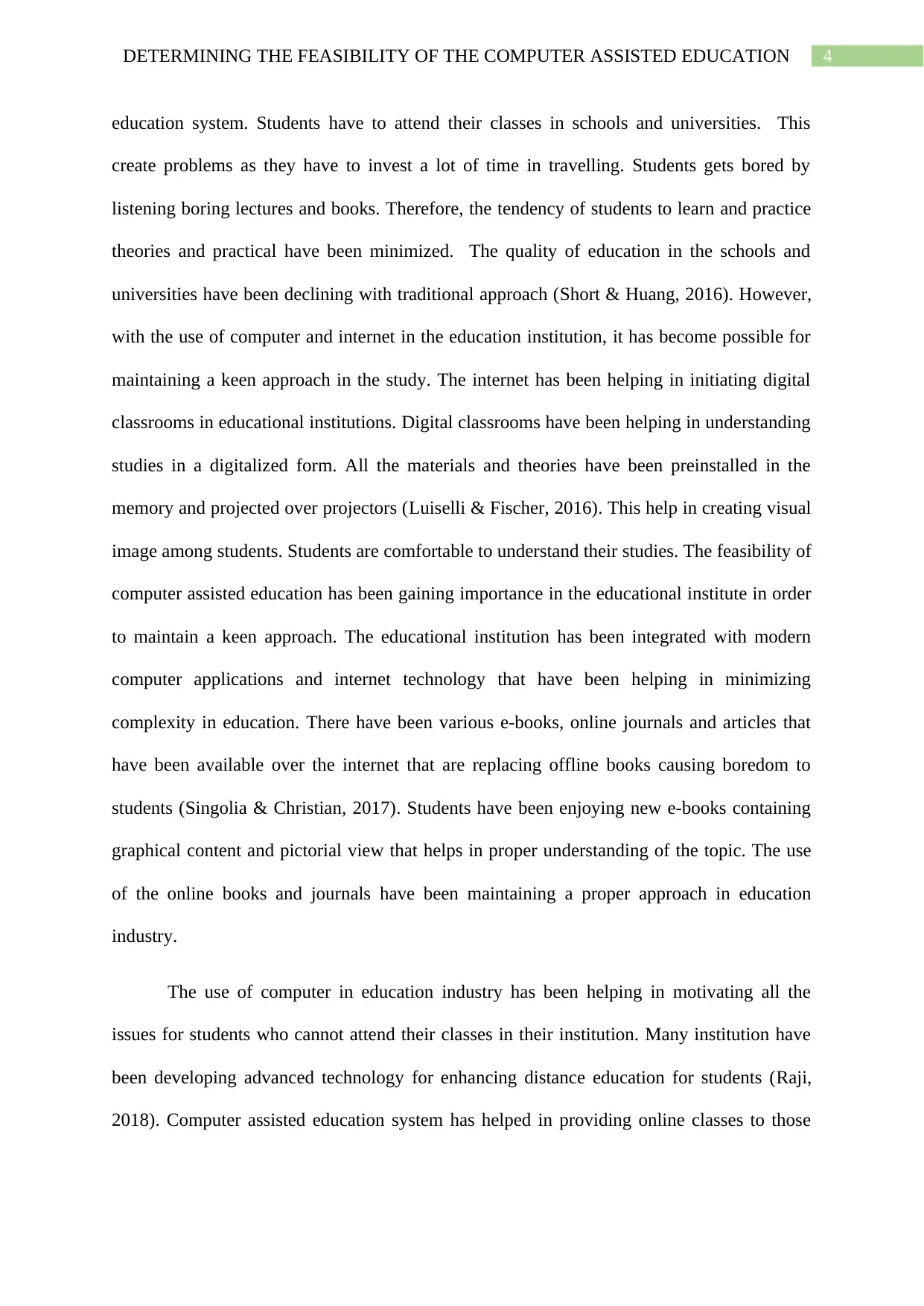
4DETERMINING THE FEASIBILITY OF THE COMPUTER ASSISTED EDUCATION
education system. Students have to attend their classes in schools and universities. This
create problems as they have to invest a lot of time in travelling. Students gets bored by
listening boring lectures and books. Therefore, the tendency of students to learn and practice
theories and practical have been minimized. The quality of education in the schools and
universities have been declining with traditional approach (Short & Huang, 2016). However,
with the use of computer and internet in the education institution, it has become possible for
maintaining a keen approach in the study. The internet has been helping in initiating digital
classrooms in educational institutions. Digital classrooms have been helping in understanding
studies in a digitalized form. All the materials and theories have been preinstalled in the
memory and projected over projectors (Luiselli & Fischer, 2016). This help in creating visual
image among students. Students are comfortable to understand their studies. The feasibility of
computer assisted education has been gaining importance in the educational institute in order
to maintain a keen approach. The educational institution has been integrated with modern
computer applications and internet technology that have been helping in minimizing
complexity in education. There have been various e-books, online journals and articles that
have been available over the internet that are replacing offline books causing boredom to
students (Singolia & Christian, 2017). Students have been enjoying new e-books containing
graphical content and pictorial view that helps in proper understanding of the topic. The use
of the online books and journals have been maintaining a proper approach in education
industry.
The use of computer in education industry has been helping in motivating all the
issues for students who cannot attend their classes in their institution. Many institution have
been developing advanced technology for enhancing distance education for students (Raji,
2018). Computer assisted education system has helped in providing online classes to those
education system. Students have to attend their classes in schools and universities. This
create problems as they have to invest a lot of time in travelling. Students gets bored by
listening boring lectures and books. Therefore, the tendency of students to learn and practice
theories and practical have been minimized. The quality of education in the schools and
universities have been declining with traditional approach (Short & Huang, 2016). However,
with the use of computer and internet in the education institution, it has become possible for
maintaining a keen approach in the study. The internet has been helping in initiating digital
classrooms in educational institutions. Digital classrooms have been helping in understanding
studies in a digitalized form. All the materials and theories have been preinstalled in the
memory and projected over projectors (Luiselli & Fischer, 2016). This help in creating visual
image among students. Students are comfortable to understand their studies. The feasibility of
computer assisted education has been gaining importance in the educational institute in order
to maintain a keen approach. The educational institution has been integrated with modern
computer applications and internet technology that have been helping in minimizing
complexity in education. There have been various e-books, online journals and articles that
have been available over the internet that are replacing offline books causing boredom to
students (Singolia & Christian, 2017). Students have been enjoying new e-books containing
graphical content and pictorial view that helps in proper understanding of the topic. The use
of the online books and journals have been maintaining a proper approach in education
industry.
The use of computer in education industry has been helping in motivating all the
issues for students who cannot attend their classes in their institution. Many institution have
been developing advanced technology for enhancing distance education for students (Raji,
2018). Computer assisted education system has helped in providing online classes to those
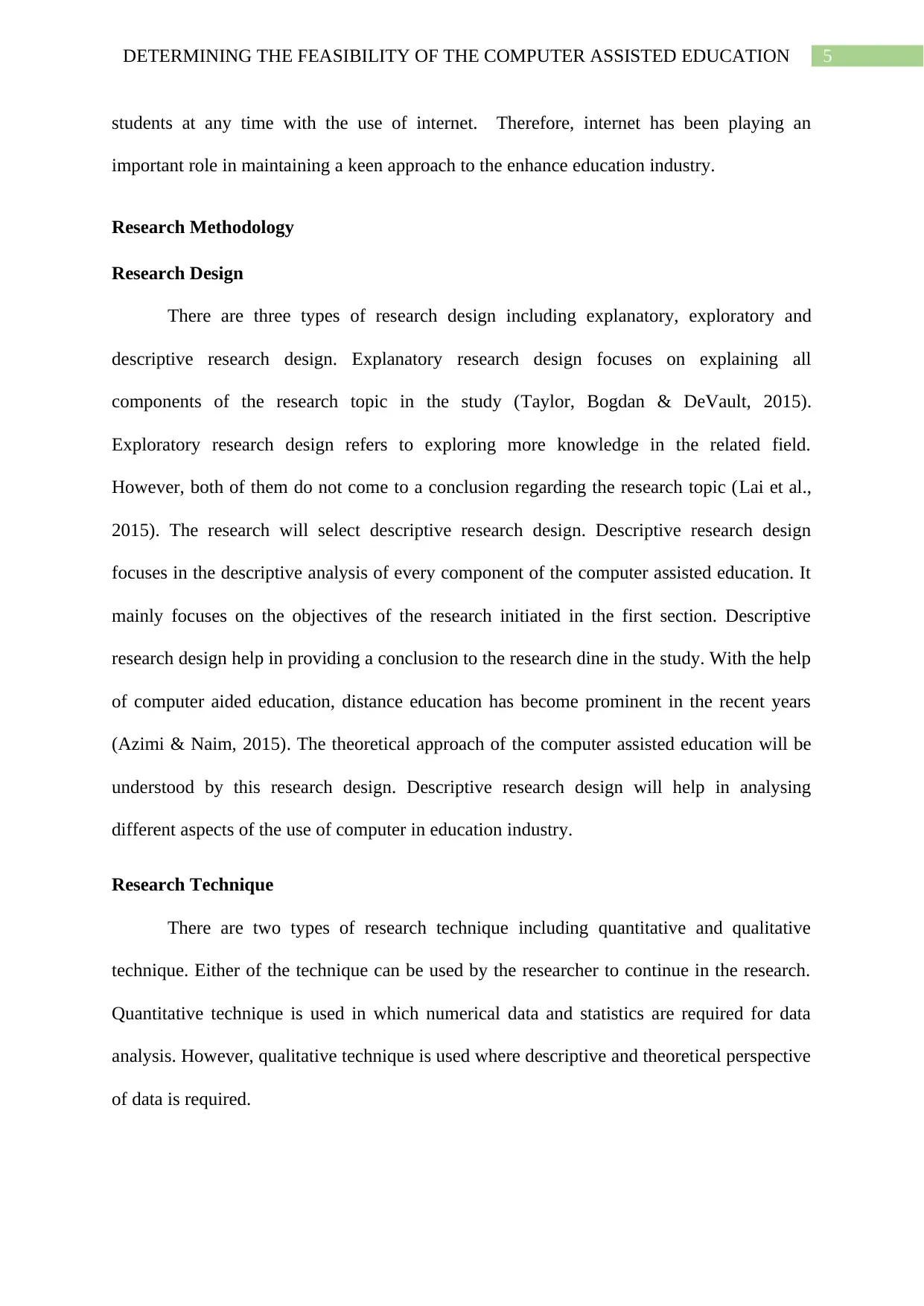
5DETERMINING THE FEASIBILITY OF THE COMPUTER ASSISTED EDUCATION
students at any time with the use of internet. Therefore, internet has been playing an
important role in maintaining a keen approach to the enhance education industry.
Research Methodology
Research Design
There are three types of research design including explanatory, exploratory and
descriptive research design. Explanatory research design focuses on explaining all
components of the research topic in the study (Taylor, Bogdan & DeVault, 2015).
Exploratory research design refers to exploring more knowledge in the related field.
However, both of them do not come to a conclusion regarding the research topic (Lai et al.,
2015). The research will select descriptive research design. Descriptive research design
focuses in the descriptive analysis of every component of the computer assisted education. It
mainly focuses on the objectives of the research initiated in the first section. Descriptive
research design help in providing a conclusion to the research dine in the study. With the help
of computer aided education, distance education has become prominent in the recent years
(Azimi & Naim, 2015). The theoretical approach of the computer assisted education will be
understood by this research design. Descriptive research design will help in analysing
different aspects of the use of computer in education industry.
Research Technique
There are two types of research technique including quantitative and qualitative
technique. Either of the technique can be used by the researcher to continue in the research.
Quantitative technique is used in which numerical data and statistics are required for data
analysis. However, qualitative technique is used where descriptive and theoretical perspective
of data is required.
students at any time with the use of internet. Therefore, internet has been playing an
important role in maintaining a keen approach to the enhance education industry.
Research Methodology
Research Design
There are three types of research design including explanatory, exploratory and
descriptive research design. Explanatory research design focuses on explaining all
components of the research topic in the study (Taylor, Bogdan & DeVault, 2015).
Exploratory research design refers to exploring more knowledge in the related field.
However, both of them do not come to a conclusion regarding the research topic (Lai et al.,
2015). The research will select descriptive research design. Descriptive research design
focuses in the descriptive analysis of every component of the computer assisted education. It
mainly focuses on the objectives of the research initiated in the first section. Descriptive
research design help in providing a conclusion to the research dine in the study. With the help
of computer aided education, distance education has become prominent in the recent years
(Azimi & Naim, 2015). The theoretical approach of the computer assisted education will be
understood by this research design. Descriptive research design will help in analysing
different aspects of the use of computer in education industry.
Research Technique
There are two types of research technique including quantitative and qualitative
technique. Either of the technique can be used by the researcher to continue in the research.
Quantitative technique is used in which numerical data and statistics are required for data
analysis. However, qualitative technique is used where descriptive and theoretical perspective
of data is required.
You're viewing a preview
Unlock full access by subscribing today!
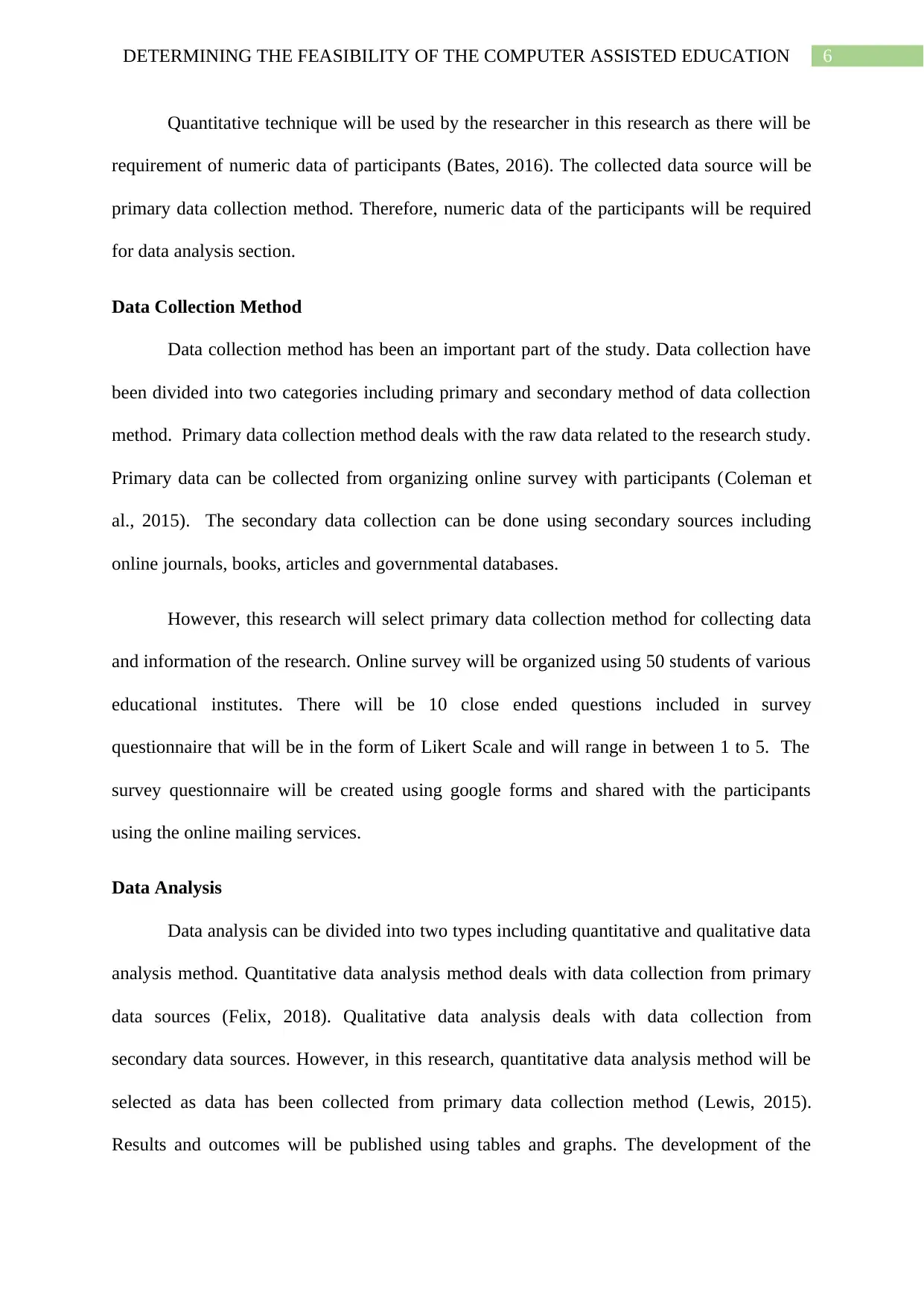
6DETERMINING THE FEASIBILITY OF THE COMPUTER ASSISTED EDUCATION
Quantitative technique will be used by the researcher in this research as there will be
requirement of numeric data of participants (Bates, 2016). The collected data source will be
primary data collection method. Therefore, numeric data of the participants will be required
for data analysis section.
Data Collection Method
Data collection method has been an important part of the study. Data collection have
been divided into two categories including primary and secondary method of data collection
method. Primary data collection method deals with the raw data related to the research study.
Primary data can be collected from organizing online survey with participants (Coleman et
al., 2015). The secondary data collection can be done using secondary sources including
online journals, books, articles and governmental databases.
However, this research will select primary data collection method for collecting data
and information of the research. Online survey will be organized using 50 students of various
educational institutes. There will be 10 close ended questions included in survey
questionnaire that will be in the form of Likert Scale and will range in between 1 to 5. The
survey questionnaire will be created using google forms and shared with the participants
using the online mailing services.
Data Analysis
Data analysis can be divided into two types including quantitative and qualitative data
analysis method. Quantitative data analysis method deals with data collection from primary
data sources (Felix, 2018). Qualitative data analysis deals with data collection from
secondary data sources. However, in this research, quantitative data analysis method will be
selected as data has been collected from primary data collection method (Lewis, 2015).
Results and outcomes will be published using tables and graphs. The development of the
Quantitative technique will be used by the researcher in this research as there will be
requirement of numeric data of participants (Bates, 2016). The collected data source will be
primary data collection method. Therefore, numeric data of the participants will be required
for data analysis section.
Data Collection Method
Data collection method has been an important part of the study. Data collection have
been divided into two categories including primary and secondary method of data collection
method. Primary data collection method deals with the raw data related to the research study.
Primary data can be collected from organizing online survey with participants (Coleman et
al., 2015). The secondary data collection can be done using secondary sources including
online journals, books, articles and governmental databases.
However, this research will select primary data collection method for collecting data
and information of the research. Online survey will be organized using 50 students of various
educational institutes. There will be 10 close ended questions included in survey
questionnaire that will be in the form of Likert Scale and will range in between 1 to 5. The
survey questionnaire will be created using google forms and shared with the participants
using the online mailing services.
Data Analysis
Data analysis can be divided into two types including quantitative and qualitative data
analysis method. Quantitative data analysis method deals with data collection from primary
data sources (Felix, 2018). Qualitative data analysis deals with data collection from
secondary data sources. However, in this research, quantitative data analysis method will be
selected as data has been collected from primary data collection method (Lewis, 2015).
Results and outcomes will be published using tables and graphs. The development of the
Paraphrase This Document
Need a fresh take? Get an instant paraphrase of this document with our AI Paraphraser
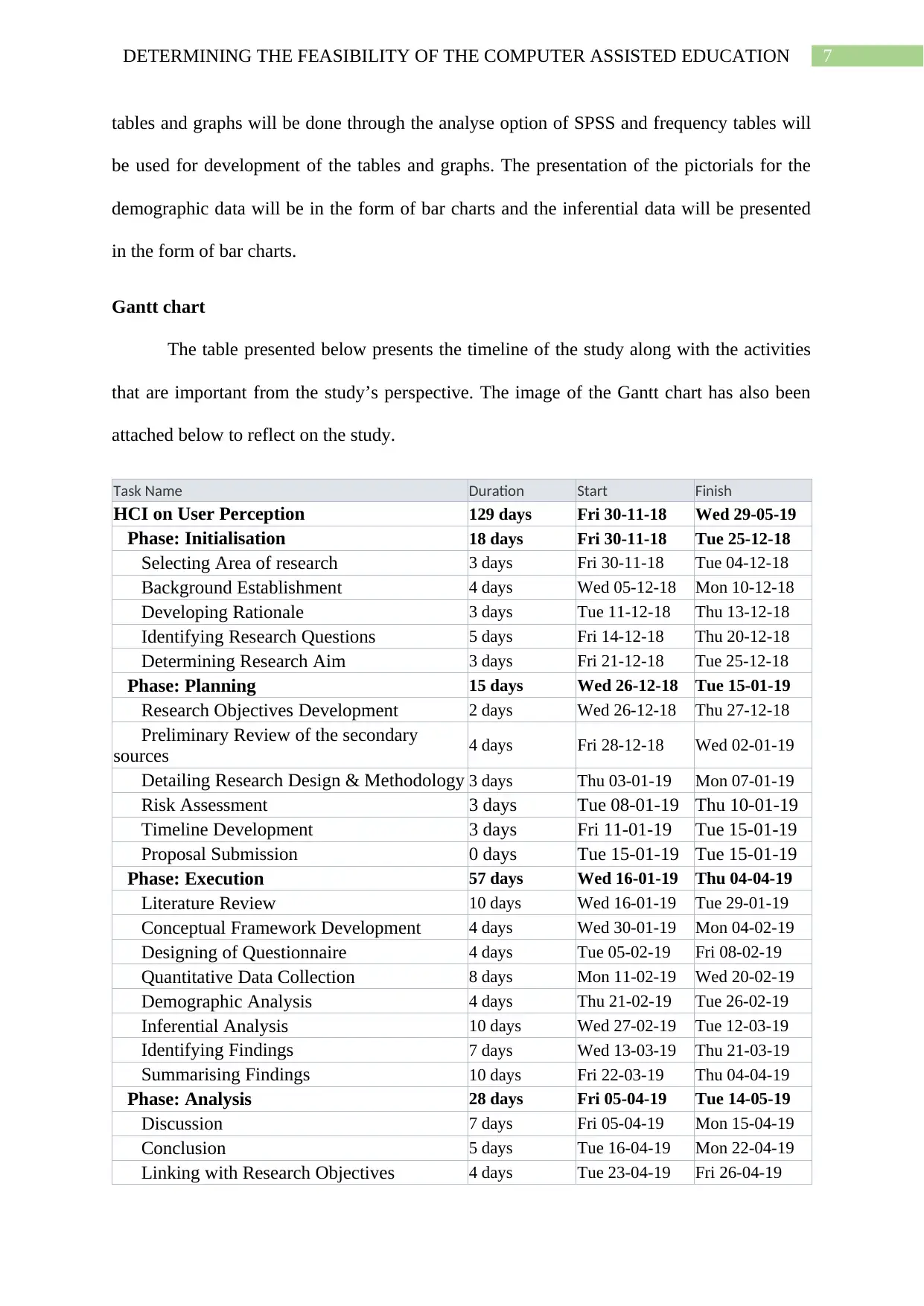
7DETERMINING THE FEASIBILITY OF THE COMPUTER ASSISTED EDUCATION
tables and graphs will be done through the analyse option of SPSS and frequency tables will
be used for development of the tables and graphs. The presentation of the pictorials for the
demographic data will be in the form of bar charts and the inferential data will be presented
in the form of bar charts.
Gantt chart
The table presented below presents the timeline of the study along with the activities
that are important from the study’s perspective. The image of the Gantt chart has also been
attached below to reflect on the study.
Task Name Duration Start Finish
HCI on User Perception 129 days Fri 30-11-18 Wed 29-05-19
Phase: Initialisation 18 days Fri 30-11-18 Tue 25-12-18
Selecting Area of research 3 days Fri 30-11-18 Tue 04-12-18
Background Establishment 4 days Wed 05-12-18 Mon 10-12-18
Developing Rationale 3 days Tue 11-12-18 Thu 13-12-18
Identifying Research Questions 5 days Fri 14-12-18 Thu 20-12-18
Determining Research Aim 3 days Fri 21-12-18 Tue 25-12-18
Phase: Planning 15 days Wed 26-12-18 Tue 15-01-19
Research Objectives Development 2 days Wed 26-12-18 Thu 27-12-18
Preliminary Review of the secondary
sources 4 days Fri 28-12-18 Wed 02-01-19
Detailing Research Design & Methodology 3 days Thu 03-01-19 Mon 07-01-19
Risk Assessment 3 days Tue 08-01-19 Thu 10-01-19
Timeline Development 3 days Fri 11-01-19 Tue 15-01-19
Proposal Submission 0 days Tue 15-01-19 Tue 15-01-19
Phase: Execution 57 days Wed 16-01-19 Thu 04-04-19
Literature Review 10 days Wed 16-01-19 Tue 29-01-19
Conceptual Framework Development 4 days Wed 30-01-19 Mon 04-02-19
Designing of Questionnaire 4 days Tue 05-02-19 Fri 08-02-19
Quantitative Data Collection 8 days Mon 11-02-19 Wed 20-02-19
Demographic Analysis 4 days Thu 21-02-19 Tue 26-02-19
Inferential Analysis 10 days Wed 27-02-19 Tue 12-03-19
Identifying Findings 7 days Wed 13-03-19 Thu 21-03-19
Summarising Findings 10 days Fri 22-03-19 Thu 04-04-19
Phase: Analysis 28 days Fri 05-04-19 Tue 14-05-19
Discussion 7 days Fri 05-04-19 Mon 15-04-19
Conclusion 5 days Tue 16-04-19 Mon 22-04-19
Linking with Research Objectives 4 days Tue 23-04-19 Fri 26-04-19
tables and graphs will be done through the analyse option of SPSS and frequency tables will
be used for development of the tables and graphs. The presentation of the pictorials for the
demographic data will be in the form of bar charts and the inferential data will be presented
in the form of bar charts.
Gantt chart
The table presented below presents the timeline of the study along with the activities
that are important from the study’s perspective. The image of the Gantt chart has also been
attached below to reflect on the study.
Task Name Duration Start Finish
HCI on User Perception 129 days Fri 30-11-18 Wed 29-05-19
Phase: Initialisation 18 days Fri 30-11-18 Tue 25-12-18
Selecting Area of research 3 days Fri 30-11-18 Tue 04-12-18
Background Establishment 4 days Wed 05-12-18 Mon 10-12-18
Developing Rationale 3 days Tue 11-12-18 Thu 13-12-18
Identifying Research Questions 5 days Fri 14-12-18 Thu 20-12-18
Determining Research Aim 3 days Fri 21-12-18 Tue 25-12-18
Phase: Planning 15 days Wed 26-12-18 Tue 15-01-19
Research Objectives Development 2 days Wed 26-12-18 Thu 27-12-18
Preliminary Review of the secondary
sources 4 days Fri 28-12-18 Wed 02-01-19
Detailing Research Design & Methodology 3 days Thu 03-01-19 Mon 07-01-19
Risk Assessment 3 days Tue 08-01-19 Thu 10-01-19
Timeline Development 3 days Fri 11-01-19 Tue 15-01-19
Proposal Submission 0 days Tue 15-01-19 Tue 15-01-19
Phase: Execution 57 days Wed 16-01-19 Thu 04-04-19
Literature Review 10 days Wed 16-01-19 Tue 29-01-19
Conceptual Framework Development 4 days Wed 30-01-19 Mon 04-02-19
Designing of Questionnaire 4 days Tue 05-02-19 Fri 08-02-19
Quantitative Data Collection 8 days Mon 11-02-19 Wed 20-02-19
Demographic Analysis 4 days Thu 21-02-19 Tue 26-02-19
Inferential Analysis 10 days Wed 27-02-19 Tue 12-03-19
Identifying Findings 7 days Wed 13-03-19 Thu 21-03-19
Summarising Findings 10 days Fri 22-03-19 Thu 04-04-19
Phase: Analysis 28 days Fri 05-04-19 Tue 14-05-19
Discussion 7 days Fri 05-04-19 Mon 15-04-19
Conclusion 5 days Tue 16-04-19 Mon 22-04-19
Linking with Research Objectives 4 days Tue 23-04-19 Fri 26-04-19
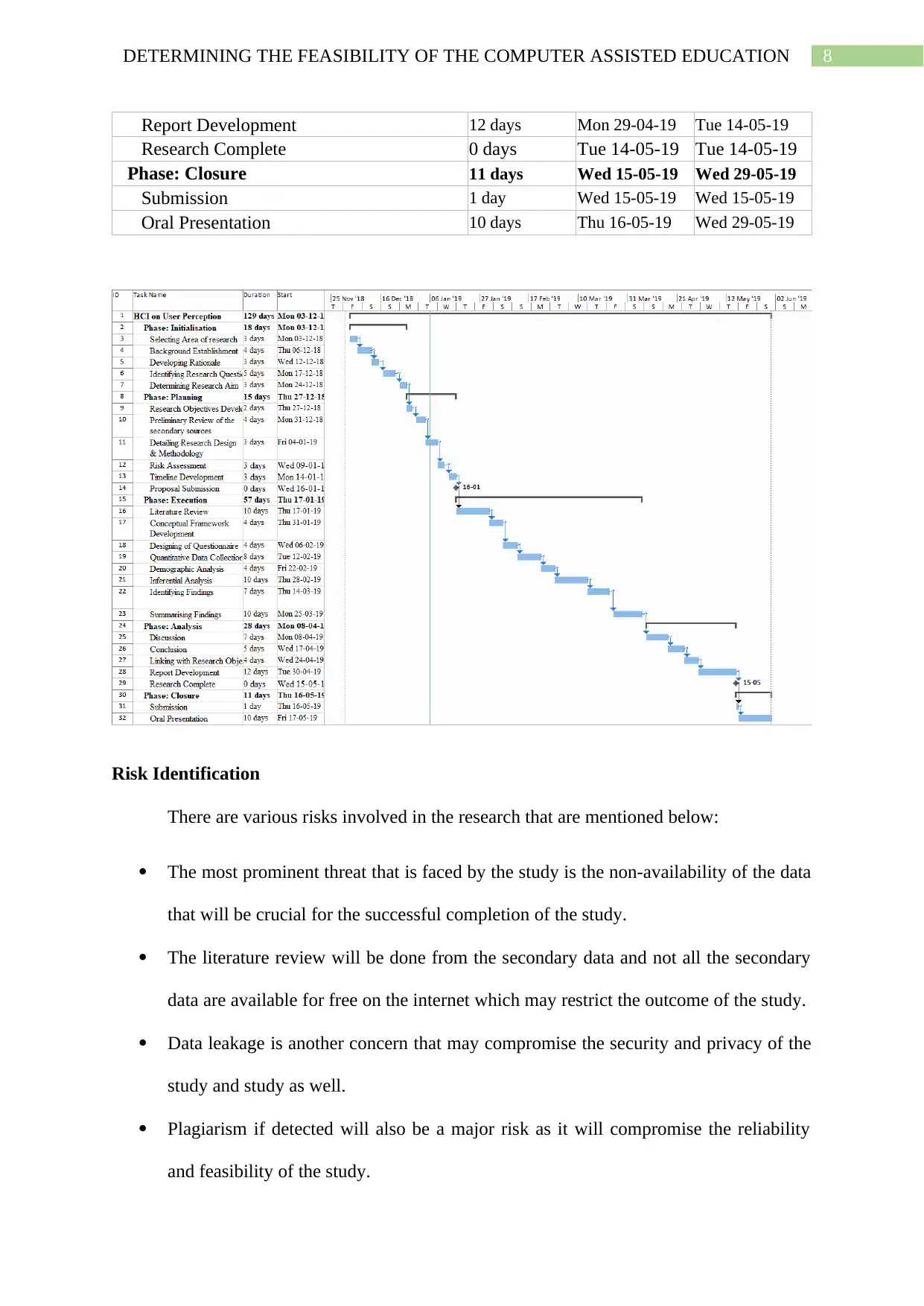
8DETERMINING THE FEASIBILITY OF THE COMPUTER ASSISTED EDUCATION
Report Development 12 days Mon 29-04-19 Tue 14-05-19
Research Complete 0 days Tue 14-05-19 Tue 14-05-19
Phase: Closure 11 days Wed 15-05-19 Wed 29-05-19
Submission 1 day Wed 15-05-19 Wed 15-05-19
Oral Presentation 10 days Thu 16-05-19 Wed 29-05-19
Risk Identification
There are various risks involved in the research that are mentioned below:
The most prominent threat that is faced by the study is the non-availability of the data
that will be crucial for the successful completion of the study.
The literature review will be done from the secondary data and not all the secondary
data are available for free on the internet which may restrict the outcome of the study.
Data leakage is another concern that may compromise the security and privacy of the
study and study as well.
Plagiarism if detected will also be a major risk as it will compromise the reliability
and feasibility of the study.
Report Development 12 days Mon 29-04-19 Tue 14-05-19
Research Complete 0 days Tue 14-05-19 Tue 14-05-19
Phase: Closure 11 days Wed 15-05-19 Wed 29-05-19
Submission 1 day Wed 15-05-19 Wed 15-05-19
Oral Presentation 10 days Thu 16-05-19 Wed 29-05-19
Risk Identification
There are various risks involved in the research that are mentioned below:
The most prominent threat that is faced by the study is the non-availability of the data
that will be crucial for the successful completion of the study.
The literature review will be done from the secondary data and not all the secondary
data are available for free on the internet which may restrict the outcome of the study.
Data leakage is another concern that may compromise the security and privacy of the
study and study as well.
Plagiarism if detected will also be a major risk as it will compromise the reliability
and feasibility of the study.
You're viewing a preview
Unlock full access by subscribing today!
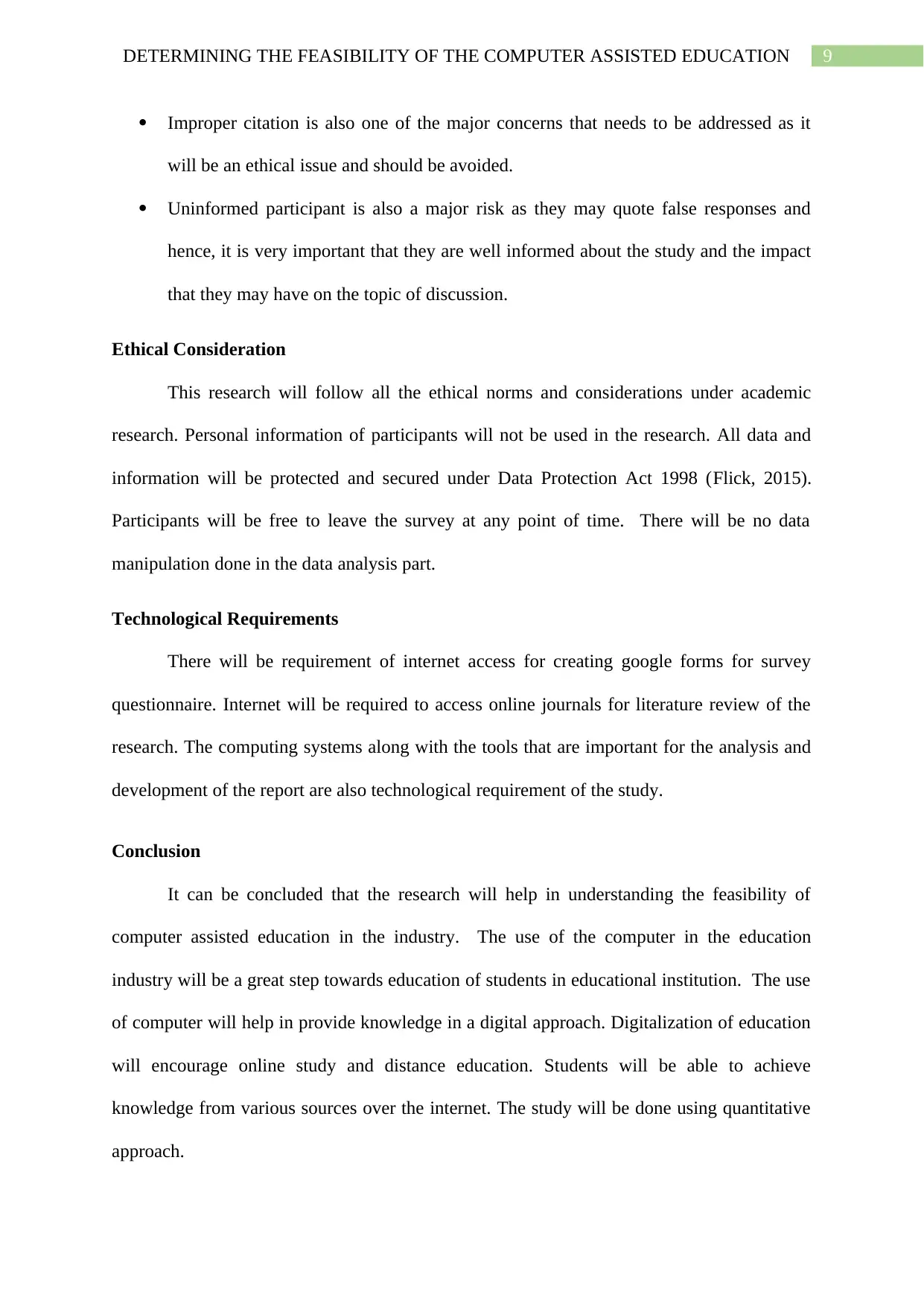
9DETERMINING THE FEASIBILITY OF THE COMPUTER ASSISTED EDUCATION
Improper citation is also one of the major concerns that needs to be addressed as it
will be an ethical issue and should be avoided.
Uninformed participant is also a major risk as they may quote false responses and
hence, it is very important that they are well informed about the study and the impact
that they may have on the topic of discussion.
Ethical Consideration
This research will follow all the ethical norms and considerations under academic
research. Personal information of participants will not be used in the research. All data and
information will be protected and secured under Data Protection Act 1998 (Flick, 2015).
Participants will be free to leave the survey at any point of time. There will be no data
manipulation done in the data analysis part.
Technological Requirements
There will be requirement of internet access for creating google forms for survey
questionnaire. Internet will be required to access online journals for literature review of the
research. The computing systems along with the tools that are important for the analysis and
development of the report are also technological requirement of the study.
Conclusion
It can be concluded that the research will help in understanding the feasibility of
computer assisted education in the industry. The use of the computer in the education
industry will be a great step towards education of students in educational institution. The use
of computer will help in provide knowledge in a digital approach. Digitalization of education
will encourage online study and distance education. Students will be able to achieve
knowledge from various sources over the internet. The study will be done using quantitative
approach.
Improper citation is also one of the major concerns that needs to be addressed as it
will be an ethical issue and should be avoided.
Uninformed participant is also a major risk as they may quote false responses and
hence, it is very important that they are well informed about the study and the impact
that they may have on the topic of discussion.
Ethical Consideration
This research will follow all the ethical norms and considerations under academic
research. Personal information of participants will not be used in the research. All data and
information will be protected and secured under Data Protection Act 1998 (Flick, 2015).
Participants will be free to leave the survey at any point of time. There will be no data
manipulation done in the data analysis part.
Technological Requirements
There will be requirement of internet access for creating google forms for survey
questionnaire. Internet will be required to access online journals for literature review of the
research. The computing systems along with the tools that are important for the analysis and
development of the report are also technological requirement of the study.
Conclusion
It can be concluded that the research will help in understanding the feasibility of
computer assisted education in the industry. The use of the computer in the education
industry will be a great step towards education of students in educational institution. The use
of computer will help in provide knowledge in a digital approach. Digitalization of education
will encourage online study and distance education. Students will be able to achieve
knowledge from various sources over the internet. The study will be done using quantitative
approach.
Paraphrase This Document
Need a fresh take? Get an instant paraphrase of this document with our AI Paraphraser
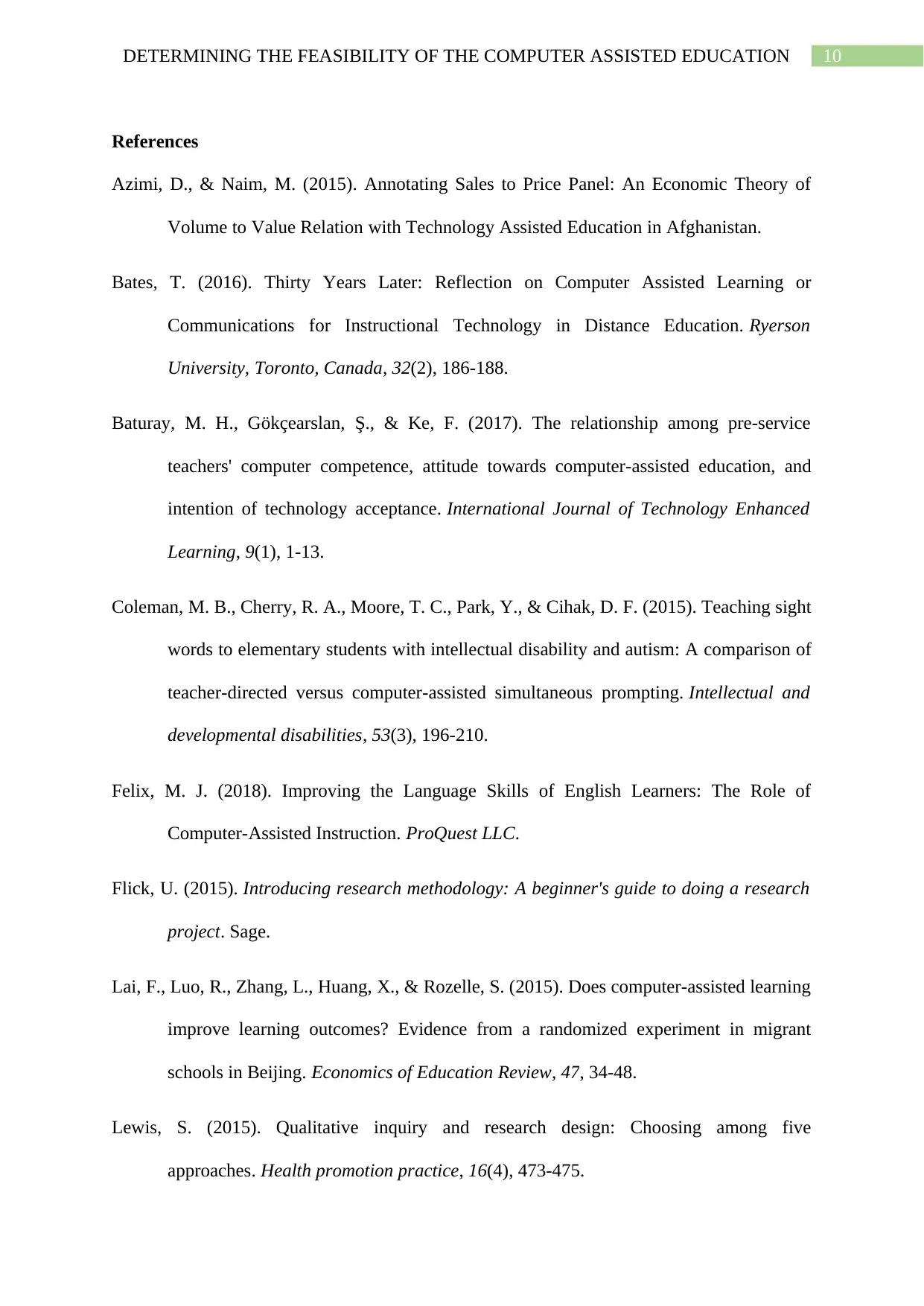
10DETERMINING THE FEASIBILITY OF THE COMPUTER ASSISTED EDUCATION
References
Azimi, D., & Naim, M. (2015). Annotating Sales to Price Panel: An Economic Theory of
Volume to Value Relation with Technology Assisted Education in Afghanistan.
Bates, T. (2016). Thirty Years Later: Reflection on Computer Assisted Learning or
Communications for Instructional Technology in Distance Education. Ryerson
University, Toronto, Canada, 32(2), 186-188.
Baturay, M. H., Gökçearslan, Ş., & Ke, F. (2017). The relationship among pre-service
teachers' computer competence, attitude towards computer-assisted education, and
intention of technology acceptance. International Journal of Technology Enhanced
Learning, 9(1), 1-13.
Coleman, M. B., Cherry, R. A., Moore, T. C., Park, Y., & Cihak, D. F. (2015). Teaching sight
words to elementary students with intellectual disability and autism: A comparison of
teacher-directed versus computer-assisted simultaneous prompting. Intellectual and
developmental disabilities, 53(3), 196-210.
Felix, M. J. (2018). Improving the Language Skills of English Learners: The Role of
Computer-Assisted Instruction. ProQuest LLC.
Flick, U. (2015). Introducing research methodology: A beginner's guide to doing a research
project. Sage.
Lai, F., Luo, R., Zhang, L., Huang, X., & Rozelle, S. (2015). Does computer-assisted learning
improve learning outcomes? Evidence from a randomized experiment in migrant
schools in Beijing. Economics of Education Review, 47, 34-48.
Lewis, S. (2015). Qualitative inquiry and research design: Choosing among five
approaches. Health promotion practice, 16(4), 473-475.
References
Azimi, D., & Naim, M. (2015). Annotating Sales to Price Panel: An Economic Theory of
Volume to Value Relation with Technology Assisted Education in Afghanistan.
Bates, T. (2016). Thirty Years Later: Reflection on Computer Assisted Learning or
Communications for Instructional Technology in Distance Education. Ryerson
University, Toronto, Canada, 32(2), 186-188.
Baturay, M. H., Gökçearslan, Ş., & Ke, F. (2017). The relationship among pre-service
teachers' computer competence, attitude towards computer-assisted education, and
intention of technology acceptance. International Journal of Technology Enhanced
Learning, 9(1), 1-13.
Coleman, M. B., Cherry, R. A., Moore, T. C., Park, Y., & Cihak, D. F. (2015). Teaching sight
words to elementary students with intellectual disability and autism: A comparison of
teacher-directed versus computer-assisted simultaneous prompting. Intellectual and
developmental disabilities, 53(3), 196-210.
Felix, M. J. (2018). Improving the Language Skills of English Learners: The Role of
Computer-Assisted Instruction. ProQuest LLC.
Flick, U. (2015). Introducing research methodology: A beginner's guide to doing a research
project. Sage.
Lai, F., Luo, R., Zhang, L., Huang, X., & Rozelle, S. (2015). Does computer-assisted learning
improve learning outcomes? Evidence from a randomized experiment in migrant
schools in Beijing. Economics of Education Review, 47, 34-48.
Lewis, S. (2015). Qualitative inquiry and research design: Choosing among five
approaches. Health promotion practice, 16(4), 473-475.
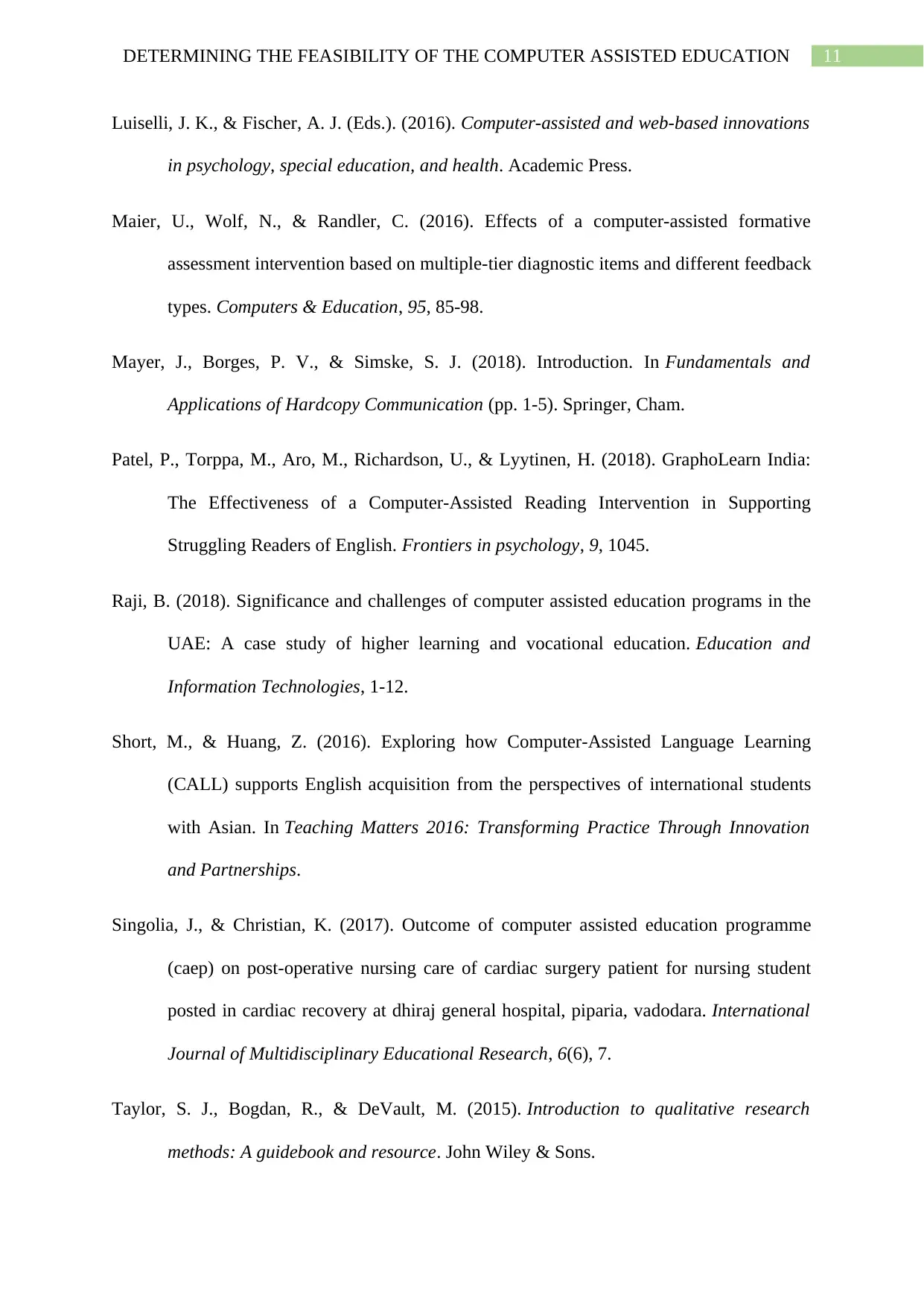
11DETERMINING THE FEASIBILITY OF THE COMPUTER ASSISTED EDUCATION
Luiselli, J. K., & Fischer, A. J. (Eds.). (2016). Computer-assisted and web-based innovations
in psychology, special education, and health. Academic Press.
Maier, U., Wolf, N., & Randler, C. (2016). Effects of a computer-assisted formative
assessment intervention based on multiple-tier diagnostic items and different feedback
types. Computers & Education, 95, 85-98.
Mayer, J., Borges, P. V., & Simske, S. J. (2018). Introduction. In Fundamentals and
Applications of Hardcopy Communication (pp. 1-5). Springer, Cham.
Patel, P., Torppa, M., Aro, M., Richardson, U., & Lyytinen, H. (2018). GraphoLearn India:
The Effectiveness of a Computer-Assisted Reading Intervention in Supporting
Struggling Readers of English. Frontiers in psychology, 9, 1045.
Raji, B. (2018). Significance and challenges of computer assisted education programs in the
UAE: A case study of higher learning and vocational education. Education and
Information Technologies, 1-12.
Short, M., & Huang, Z. (2016). Exploring how Computer-Assisted Language Learning
(CALL) supports English acquisition from the perspectives of international students
with Asian. In Teaching Matters 2016: Transforming Practice Through Innovation
and Partnerships.
Singolia, J., & Christian, K. (2017). Outcome of computer assisted education programme
(caep) on post-operative nursing care of cardiac surgery patient for nursing student
posted in cardiac recovery at dhiraj general hospital, piparia, vadodara. International
Journal of Multidisciplinary Educational Research, 6(6), 7.
Taylor, S. J., Bogdan, R., & DeVault, M. (2015). Introduction to qualitative research
methods: A guidebook and resource. John Wiley & Sons.
Luiselli, J. K., & Fischer, A. J. (Eds.). (2016). Computer-assisted and web-based innovations
in psychology, special education, and health. Academic Press.
Maier, U., Wolf, N., & Randler, C. (2016). Effects of a computer-assisted formative
assessment intervention based on multiple-tier diagnostic items and different feedback
types. Computers & Education, 95, 85-98.
Mayer, J., Borges, P. V., & Simske, S. J. (2018). Introduction. In Fundamentals and
Applications of Hardcopy Communication (pp. 1-5). Springer, Cham.
Patel, P., Torppa, M., Aro, M., Richardson, U., & Lyytinen, H. (2018). GraphoLearn India:
The Effectiveness of a Computer-Assisted Reading Intervention in Supporting
Struggling Readers of English. Frontiers in psychology, 9, 1045.
Raji, B. (2018). Significance and challenges of computer assisted education programs in the
UAE: A case study of higher learning and vocational education. Education and
Information Technologies, 1-12.
Short, M., & Huang, Z. (2016). Exploring how Computer-Assisted Language Learning
(CALL) supports English acquisition from the perspectives of international students
with Asian. In Teaching Matters 2016: Transforming Practice Through Innovation
and Partnerships.
Singolia, J., & Christian, K. (2017). Outcome of computer assisted education programme
(caep) on post-operative nursing care of cardiac surgery patient for nursing student
posted in cardiac recovery at dhiraj general hospital, piparia, vadodara. International
Journal of Multidisciplinary Educational Research, 6(6), 7.
Taylor, S. J., Bogdan, R., & DeVault, M. (2015). Introduction to qualitative research
methods: A guidebook and resource. John Wiley & Sons.
You're viewing a preview
Unlock full access by subscribing today!

12DETERMINING THE FEASIBILITY OF THE COMPUTER ASSISTED EDUCATION
1 out of 13
Related Documents
Your All-in-One AI-Powered Toolkit for Academic Success.
+13062052269
info@desklib.com
Available 24*7 on WhatsApp / Email
![[object Object]](/_next/static/media/star-bottom.7253800d.svg)
Unlock your academic potential
© 2024 | Zucol Services PVT LTD | All rights reserved.





